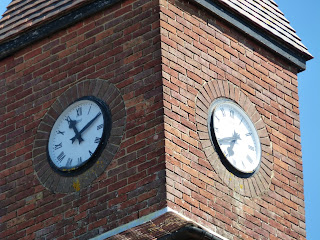Just to the north of the station is the church of St Paul's, consecrated in 1853.
Of a more recent vintage is the clock tower of the Sainsbury's supermarket. A fairly simple clock on a very uninspiring tower, but it is there and so is included here.
Much more inspiring, and my reason for visiting Salisbury, is the clock tower by Fisherton Bridge
.
The clock tower is a memorial to the wife of Dr John Roberts, and was completed in June 1893.
The clock itself is by Smith of Derby. The original mechanism was replaced in December 1970.
Next up is the entrance to Market Walk. Salisbury was granted the right to hold a market by King Henry III in 1227, but I am guessing that this building and its clock are slightly (!) later in date.
I love this next clock in New Canal Street.
Its rather dilapidated state lends it a form of dignity and gravitas. And Electric House - what a great name compared to the rubbish ones you get on more modern buildings. I assume it had some connection with its original use (Electricity Board?), but is now a branch of Blacks the outdoor clothing retailer - will it be re-named Hiking House?
Even more lovely is the W H Smith clock on what is now a branch of Waterstones. The building was originally the Assembly Rooms, but was bought by W H Smith in 1924.
Although not all the hands are in the condition they are meant to be, the glorious colour of the clock face makes it a wonder to behold, and one of my favourite clocks of all time.
The weathervane apparently represents a W H Smith newsboy.
Finally, St Thomas of Canterbury church. This is located right in the heart of the town and is hard to find how to get close to it.
And after walking round and round and being blocked by other buildings, you finally notice the little alleyways that lead to the church, the main one being indicated by the sign below.
The sign also indicates that the church dates from 1220, although most of the actual building dates from the 15th century.










































No comments:
Post a Comment